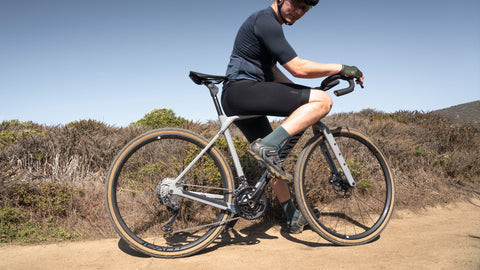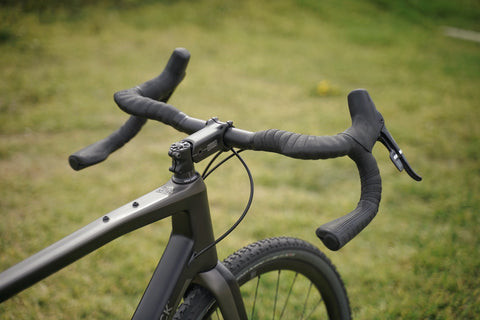Can You Use A Road Bike As A Gravel Bike? Absolutely! Converting your road bike into a gravel-ready machine is simpler than you might think, and usabikers.net is here to guide you through the process. With some strategic modifications, you can transform your road bike into a versatile adventure companion, opening up a world of off-road possibilities. Whether it’s swapping tires, adjusting gears, or adding comfort-enhancing components, we’ll provide you with the insights you need to conquer those gravel paths. Get ready to explore bike conversions, gravel cycling, and bike modifications.
1. Understanding the Appeal of Gravel Biking
Gravel biking has exploded in popularity, capturing the hearts of both seasoned road cyclists and adventurous mountain bikers. But what exactly makes gravel biking so appealing?
Gravel biking offers a unique blend of road cycling and mountain biking, allowing riders to explore a variety of terrains, from smooth pavement to rough gravel paths. This versatility is a major draw for those seeking adventure beyond the confines of paved roads. According to a study by the Adventure Cycling Association, gravel riding has seen a 30% increase in participation over the last five years, highlighting its growing appeal.
1.1. Freedom and Exploration
One of the primary reasons people are drawn to gravel biking is the sense of freedom and exploration it provides. Gravel roads often lead to remote and scenic locations that are inaccessible to traditional road bikes. This opens up a world of possibilities for discovering hidden gems and enjoying the tranquility of nature.
1.2. Versatility and Adaptability
Gravel bikes are designed to handle a variety of surfaces, making them incredibly versatile. Whether you’re tackling smooth pavement, rough gravel, or even some singletrack trails, a gravel bike can handle it all. This adaptability makes them a great choice for riders who want a bike that can do it all.
1.3. A Welcoming Community
The gravel biking community is known for its inclusivity and welcoming atmosphere. Unlike some other cycling disciplines, gravel biking emphasizes camaraderie and shared experiences over competition. This makes it a great way to connect with other riders and enjoy the social aspect of cycling.
2. Assessing Your Road Bike’s Suitability
Before diving into the conversion process, it’s important to assess whether your road bike is a good candidate for gravel riding. Not all road bikes are created equal, and some may be better suited for gravel conversion than others.
2.1. Tire Clearance: The Most Important Factor
The most crucial factor to consider is tire clearance. Gravel tires are wider than road tires, providing better traction and comfort on rough surfaces. However, not all road bikes have enough clearance in the frame and fork to accommodate wider tires.
To determine your bike’s tire clearance, measure the distance between the tire and the frame/fork at its tightest points. Ideally, you’ll want at least 4-6mm of clearance on each side to prevent rubbing. According to a survey by BikeRadar in December 2024, most modern road bikes can accommodate tires up to 28-32mm wide, while some can even handle 35mm or wider.
2.2. Frame Material and Geometry
The frame material and geometry can also play a role in your bike’s suitability for gravel riding. Frames made from steel or titanium tend to be more comfortable and forgiving than those made from aluminum or carbon fiber, making them better suited for rough surfaces.
Additionally, a road bike with a more relaxed geometry (longer wheelbase, slacker head tube angle) will generally be more stable and comfortable on gravel than a bike with a more aggressive, race-oriented geometry.
2.3. Brake Type: Rim vs. Disc
Another factor to consider is the type of brakes your bike has. Disc brakes offer superior stopping power and modulation compared to rim brakes, especially in wet or muddy conditions. If your road bike has rim brakes, you may find that they lack the necessary performance for confident gravel riding.
3. Essential Modifications: Transforming Your Road Bike
Once you’ve assessed your road bike’s suitability, it’s time to start making the necessary modifications to transform it into a gravel-worthy machine. Here are some key areas to focus on:
3.1. Wider Tires: The Foundation of Gravel Performance
Installing wider tires is the single most important modification you can make to your road bike for gravel riding. Wider tires provide better traction, comfort, and puncture resistance on rough surfaces.
 Gravel bike tires provide better traction and comfort
Gravel bike tires provide better traction and comfort
3.1.1. Determining the Right Tire Width
As mentioned earlier, the maximum tire width you can fit will depend on your bike’s frame and fork clearance. Consult your bike’s owner’s manual or measure the clearance yourself to determine the widest tires you can safely run.
According to a recent article in “VeloNews”, a tire width of 38-45mm is ideal for most gravel riding, providing a good balance of speed and comfort.
3.1.2. Choosing the Right Tire Tread
In addition to width, you’ll also want to consider the tire tread pattern. Gravel tires typically have a more aggressive tread pattern than road tires, providing better grip on loose surfaces.
- File Tread: Ideal for smoother gravel roads and hardpack surfaces.
- Semi-slick Tread: Offers a good balance of speed and traction for mixed-terrain riding.
- Knobby Tread: Provides maximum grip on loose, muddy, or technical terrain.
3.1.3. Tubeless Setup: Enhanced Performance and Puncture Resistance
Consider setting up your gravel tires tubeless. Tubeless tires allow you to run lower pressures without the risk of pinch flats, improving traction and comfort. They also self-seal small punctures, reducing the likelihood of getting stranded on the trail.
3.2. Gearing Adjustments: Conquering Steep Climbs
Gravel riding often involves tackling steep climbs and navigating technical terrain. To make these challenges easier, you may need to adjust your bike’s gearing.
3.2.1. Wider-Range Cassette: More Gears for More Terrain
Swapping out your cassette for a wider-range model can provide you with more gears for climbing and descending. A cassette with a larger low gear (e.g., 11-36T or 11-40T) will make steep climbs much easier, while a larger high gear will allow you to maintain speed on flat or downhill sections.
3.2.2. Smaller Chainring: Easier Climbing
Consider installing a smaller chainring to further lower your gear ratio. A smaller chainring will make it easier to pedal up steep hills, especially when combined with a wider-range cassette.
3.2.3. 1x Drivetrain: Simplicity and Reliability
Some gravel riders prefer to run a 1x (one-by) drivetrain, which eliminates the front derailleur and provides a simpler, more reliable setup. With a 1x drivetrain, you only have one chainring in the front, which simplifies shifting and reduces the risk of dropped chains.
3.3. Handlebar Swap: Comfort and Control
Swapping out your road handlebars for gravel-specific handlebars can significantly improve your comfort and control on rough terrain.
 Gravel bike handlebar provides control and stability for riding on rough terrain
Gravel bike handlebar provides control and stability for riding on rough terrain
3.3.1. Wider Bars: Increased Stability
Gravel handlebars are generally wider than road bars, providing increased stability and control on loose surfaces. A wider handlebar also opens up your chest, making it easier to breathe when climbing.
3.3.2. Flared Drops: Enhanced Control in the Drops
Many gravel handlebars feature flared drops, which angle outward to provide a wider hand position. This wider hand position increases control and stability when riding in the drops, especially on rough terrain.
3.3.3. Vibration Damping: Reducing Fatigue
Look for gravel handlebars that offer some degree of vibration damping. Some handlebars are made from materials like carbon fiber or feature gel inserts to help absorb road vibrations and reduce fatigue.
3.4. Comfort Enhancements: Smoothing Out the Ride
Gravel riding can be tough on your body, so it’s important to prioritize comfort. Here are some additional modifications you can make to smooth out the ride:
3.4.1. Suspension Seatpost: Absorbing Bumps and Vibrations
A suspension seatpost can significantly improve your comfort by absorbing bumps and vibrations from the road. Suspension seatposts use a spring or elastomer to provide a small amount of vertical travel, effectively smoothing out the ride.
3.4.2. Suspension Stem: Front-End Compliance
A suspension stem is another option for adding front-end compliance to your road bike. Like suspension seatposts, suspension stems use a spring or elastomer to absorb shocks and vibrations, reducing fatigue in your hands and arms.
3.4.3. Gel Bar Tape: Hand Comfort
Wrapping your handlebars with gel bar tape can provide additional cushioning and comfort for your hands. Gel bar tape helps to absorb vibrations and reduce pressure points, making long rides more enjoyable.
3.5. Gravel-Specific Accessories: Enhancing Your Ride
In addition to the above modifications, there are a number of gravel-specific accessories that can enhance your riding experience:
3.5.1. Frame Bags: Carrying Essentials
Frame bags attach to your bike’s frame and provide a convenient way to carry essential items like tools, spare tubes, and snacks. Frame bags come in a variety of sizes and shapes to fit different bike frames.
3.5.2. Fenders: Staying Dry and Clean
Fenders can help to keep you dry and clean when riding in wet or muddy conditions. Fenders attach to your bike’s frame and wheels and deflect water and mud away from you.
3.5.3. GPS Computer: Navigation and Data Tracking
A GPS computer can provide you with navigation, data tracking, and other useful features for your gravel rides. GPS computers can track your speed, distance, elevation, and other metrics, allowing you to monitor your progress and performance.
4. Fine-Tuning Your Fit: Optimizing Comfort and Performance
Once you’ve made the necessary modifications to your road bike, it’s important to fine-tune your fit to optimize comfort and performance.
4.1. Upright Riding Position: Increased Comfort and Control
Consider adjusting your riding position to be more upright. An upright riding position can reduce strain on your back and neck, making long rides more comfortable. It can also improve your control on rough terrain by shifting your weight further back on the bike.
You can achieve a more upright riding position by:
- Raising your handlebars by adding spacers or using a stem with a higher rise.
- Sliding your saddle forward on the rails.
- Using a shorter stem.
4.2. Saddle Choice: Comfort is Key
Choosing the right saddle is crucial for comfort on long gravel rides. Experiment with different saddle shapes and widths to find one that supports your sit bones and prevents chafing.
4.3. Cleat Position: Optimizing Power Transfer
Your cleat position can affect your pedaling efficiency and comfort. Experiment with different cleat positions to find one that allows you to pedal smoothly and efficiently without any pain or discomfort.
5. Safety Considerations: Prioritizing Your Well-being
Gravel riding can be more challenging and dangerous than road riding, so it’s important to prioritize safety.
5.1. Helmet: Always Wear One
Wearing a helmet is the most important safety precaution you can take when cycling. Make sure your helmet fits properly and is certified to meet safety standards.
5.2. Visibility: Be Seen
Increase your visibility to other road users by wearing bright clothing and using lights, especially when riding in low-light conditions.
5.3. Bike Maintenance: Regular Checkups
Regularly inspect your bike for any signs of wear or damage. Pay close attention to your tires, brakes, and drivetrain, and address any issues promptly.
5.4. Ride Prepared: Tools and Supplies
Carry a basic repair kit with you on all your gravel rides, including a spare tube, tire levers, a multi-tool, and a pump or CO2 inflator.
5.5. Know Your Limits: Don’t Overdo It
Start with shorter, less challenging gravel rides and gradually increase the distance and difficulty as you become more experienced.
6. Exploring Gravel Routes: Discovering New Adventures
Now that you’ve converted your road bike into a gravel bike, it’s time to start exploring some gravel routes.
6.1. Local Resources: Finding Gravel Roads
Use online resources like Strava Heatmaps, Ride with GPS, and local cycling clubs to find gravel roads and routes in your area.
6.2. Gradual Progression: Starting Slow
Start with shorter, less challenging gravel rides and gradually increase the distance and difficulty as you become more experienced.
6.3. Embracing the Adventure: Enjoy the Ride
Gravel riding is all about adventure and exploration, so embrace the unknown and enjoy the ride.
7. Addressing Common Concerns: Answering Your Questions
Here are some frequently asked questions about using a road bike as a gravel bike:
7.1. Will my road bike be as capable as a dedicated gravel bike?
While a converted road bike can be a capable gravel machine, it may not be as versatile or comfortable as a dedicated gravel bike. Dedicated gravel bikes are designed specifically for gravel riding, with features like more relaxed geometry, wider tire clearance, and more durable components.
7.2. Can I use my road bike for technical gravel trails?
A converted road bike can handle some technical gravel trails, but it may not be suitable for very rough or demanding terrain. For technical gravel trails, a dedicated gravel bike or even a mountain bike may be a better choice.
7.3. How much will it cost to convert my road bike to a gravel bike?
The cost of converting your road bike to a gravel bike will depend on the modifications you make. Wider tires are relatively inexpensive, while a new cassette, handlebars, or suspension components can be more costly.
8. Real-World Examples: Success Stories
Many cyclists have successfully converted their road bikes into capable gravel machines. Here are a few examples:
- Sarah’s Story: Sarah converted her old road bike into a gravel bike by installing wider tires and a wider-range cassette. She now uses it for exploring gravel roads and trails near her home.
- Tom’s Story: Tom added a suspension seatpost and stem to his road bike to make it more comfortable for gravel riding. He now uses it for long-distance gravel adventures.
9. Usabikers.net: Your Resource for Gravel Biking Adventures
Usabikers.net is your ultimate resource for all things gravel biking in the USA. Whether you’re looking for information on bike conversions, gravel routes, or gear reviews, we’ve got you covered.
9.1. Explore Our Articles: In-Depth Guides
Dive into our extensive library of articles, packed with expert advice and tips on everything from choosing the right tires to planning your next gravel adventure.
9.2. Join Our Community: Connect with Fellow Riders
Connect with fellow gravel enthusiasts in our vibrant online community. Share your experiences, ask questions, and find inspiration for your next ride.
9.3. Discover Gravel Events: Races and Rides
Stay up-to-date on the latest gravel events across the USA. From local group rides to competitive races, there’s something for everyone.
10. Embrace the Gravel Revolution: Your Call to Adventure
Converting your road bike into a gravel bike is a fantastic way to expand your cycling horizons and discover new adventures. With the right modifications and a sense of adventure, you can transform your road bike into a versatile machine that’s ready to tackle any terrain. Join the gravel revolution and start exploring the world beyond the pavement. Visit usabikers.net today to learn more and connect with a community of passionate gravel riders. Your next adventure awaits!
Ready to transform your road bike and explore the world of gravel riding? Visit usabikers.net today for expert advice, community connections, and inspiration for your next adventure!
Address: 801 Sturgis Main St, Sturgis, SD 57785, United States
Phone: +1 (605) 347-2000
Website: usabikers.net
FAQ: Can You Use A Road Bike As A Gravel Bike?
1. Can I really use a road bike as a gravel bike?
Yes, you can definitely use a road bike as a gravel bike with some modifications. By making strategic changes, you can adapt your road bike for gravel riding.
2. What are the most important modifications for converting a road bike to a gravel bike?
The most important modifications include installing wider tires, adjusting the gearing, and swapping out the handlebars for gravel-specific ones. These changes will significantly improve your bike’s performance on gravel roads.
3. What tire size should I use for gravel riding on my road bike?
Aim for the widest tires that your frame can accommodate, typically between 38-45mm for optimal comfort and traction. Ensure there’s enough clearance to prevent rubbing.
4. How do I adjust the gearing on my road bike for gravel riding?
Consider installing a wider-range cassette and a smaller chainring to provide easier climbing gears. A 1x drivetrain is another option for simplified shifting.
5. Are gravel-specific handlebars really necessary?
While not strictly necessary, gravel handlebars offer increased stability and control due to their wider design and flared drops. This enhances your riding experience on rough terrain.
6. How can I improve the comfort of my road bike for gravel riding?
Adding a suspension seatpost or stem can significantly improve comfort by absorbing bumps and vibrations. Gel bar tape can also provide additional cushioning for your hands.
7. What accessories are essential for gravel riding on a converted road bike?
Essential accessories include frame bags for carrying tools and supplies, fenders for staying dry, and a GPS computer for navigation and data tracking.
8. Is it safe to ride technical gravel trails with a converted road bike?
A converted road bike can handle some technical trails, but it’s best suited for less demanding terrain. For very rough or challenging trails, a dedicated gravel bike or mountain bike may be more appropriate.
9. What should I consider when choosing a gravel route for my converted road bike?
Start with shorter, less challenging routes and gradually increase the distance and difficulty as you become more experienced. Local cycling clubs and online resources can help you find suitable gravel roads.
10. Will a converted road bike perform as well as a dedicated gravel bike?
While a converted road bike can be quite capable, it may not match the overall performance and comfort of a dedicated gravel bike, which is designed specifically for off-road riding.

